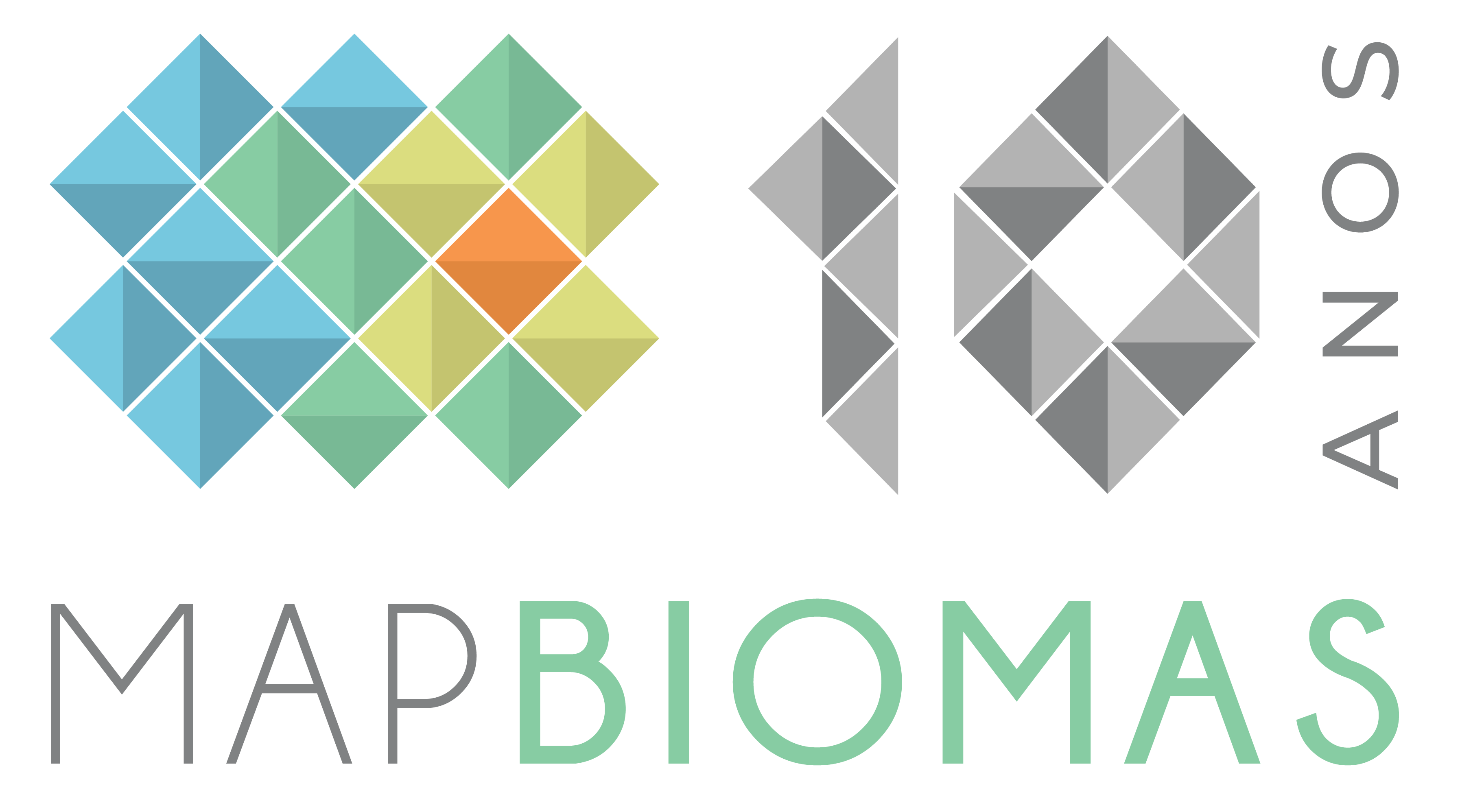From the Landsat mosaics, the classifications that result in land cover and land use maps are carried out for each year. Within the logic proposed by MapBiomas the maps will be updated every time there is an improvement in the classification algorithms. The classification methodology is dynamic and procedural, with the purpose of improving the classification of each typology.
MapBiomas Collection data can be accessed in four ways:
1. browsing on line through the MapBiomas dashboard:
✓2. Download by biome, state, municipality or anr other geometry of interest by using toolkits designed on Google Earth Engine (GEE).
✓This tool has the advantage of exporting both the map and area statistics for the selected geometries and periods. Access the tutorial video to learn how to use the toolkit. Instructions are also available on Github. The following data are currently available:
2. Access the data asset on Google Earth Engine: ID:
✓
- Land cover and use, Transition, Deforestation and Secondary Vegetation and Secondary Vegetatiton Age
projects/mapbiomas-public/assets/brazil/lulc/collection10/mapbiomas_brazil_collection10_coverage_v2 (COLLECTION 10)
projects/mapbiomas-public/assets/brazil/lulc/collection9/mapbiomas_collection90_transitions_v1 (COLEÇÃO 9)
projects/mapbiomas-public/assets/brazil/lulc/collection10/mapbiomas_brazil_collection10_deforestation_secondary_vegetation_v2 (COLEÇÃO 10)
projects/mapbiomas-public/assets/brazil/lulc/collection9/mapbiomas_collection90_secondary_vegetation_age_v1 (veja de código no GEE – COLEÇÃO 9)
- Agriculture Module (Collection 9)
projects/mapbiomas-public/assets/brazil/lulc/collection9/mapbiomas_collection90_irrigated_agriculture_v1 (veja código)
projects/mapbiomas-public/assets/brazil/lulc_10m/collection2/mapbiomas_10m_collection2_agriculture_number_cycles_v1 (código)
projects/mapbiomas-public/assets/brazil/lulc_10m/collection2/mapbiomas_10m_collection2_agriculture_mean_cycles_2017_2023_v1 (ex.)
- Mining (Industrial, Garimpo e Substância mineral princial) (coleção 10)
projects/mapbiomas-public/assets/brazil/lulc/collection10/mapbiomas_brazil_collection10_mining_substances_v3
- Pasture Module (Collection 9)
projects/mapbiomas-public/assets/brazil/lulc/collection9/mapbiomas_collection90_pasture_vigor_v1 (see GEE code example)
projects/mapbiomas-public/assets/brazil/lulc/collection9/mapbiomas_collection90_pasture_vigor_transition_v1
projects/mapbiomas-public/assets/brazil/lulc/collection9/mapbiomas_collection90_pasture_age_v1 (see GEE code example)
projects/mapbiomas-public/assets/brazil/lulc/collection9/mapbiomas_collection90_pasture_detection_year_v1 (veja exemplo de código)
projects/mapbiomas-public/assets/brazil/lulc/collection9/mapbiomas_collection90_pasture_gpp_v1 (see GEE code example)
projects/mapbiomas-public/assets/brazil/lulc/collection9/mapbiomas_collection90_pasture_last_time_mapped_v1 (veja exemplo de código)
- MapBiomas Water (collection 3)
projects/mapbiomas-public/assets/brazil/water/collection3/mapbiomas_water_annual_water_coverage_v1
projects/mapbiomas-public/assets/brazil/water/collection3/mapbiomas_water_frequency_v1
- Annual and cumulative burned area and cover (collection 3)
projects/mapbiomas-public/assets/brazil/fire/collection3/mapbiomas_fire_collection3_annual_burned_v1
projects/mapbiomas-public/assets/brazil/fire/collection3/mapbiomas_fire_collection3_annual_burned_coverage_v1
projects/mapbiomas-public/assets/brazil/fire/collection3/mapbiomas_fire_collection3_accumulated_burned_v1
projects/mapbiomas-public/assets/brazil/fire/collection3/mapbiomas_fire_collection3_accumulated_burned_coverage_v1
- MapBiomas Fire (coleção 4)
Annual and cumulative burned area and cover
projects/mapbiomas-public/assets/brazil/fire/collection4/mapbiomas_fire_collection4_annual_burned_v1
projects/mapbiomas-public/assets/brazil/fire/collection4/mapbiomas_fire_collection4_annual_burned_vectors_v1/mbfogo_col4_2024_v1 [vetorial (uma FeatureCollection por ano entre 1985 e 2024)]
projects/mapbiomas-public/assets/brazil/fire/collection4/mapbiomas_fire_collection4_annual_burned_coverage_v1
projects/mapbiomas-public/assets/brazil/fire/collection4/mapbiomas_fire_collection4_accumulated_burned_v1
projects/mapbiomas-public/assets/brazil/fire/collection4/mapbiomas_fire_collection4_accumulated_burned_coverage_v1Monthly burned area
projects/mapbiomas-public/assets/brazil/fire/collection4/mapbiomas_fire_collection4_monthly_burned_v1Annual Burned Area by Scar Size, Frequency, and Last Fire Year
projects/mapbiomas-public/assets/brazil/fire/collection4/mapbiomas_fire_collection4_annual_burned_scar_size_range_v1
projects/mapbiomas-public/assets/brazil/fire/collection4/mapbiomas_fire_collection4_fire_frequency_v1
projects/mapbiomas-public/assets/brazil/fire/collection4/mapbiomas_fire_collection4_year_last_fire_v1Área queimada mensal (Monitor do Fogo)
projects/mapbiomas-public/assets/brazil/fire/monitor/mapbiomas_fire_monthly_burned_v1
- Cover and use 10 meters (beta collection)
projects/mapbiomas-public/assets/brazil/lulc_10m/collection2/mapbiomas_10m_collection2_integration_v1
- Soil (coleção 2 beta)
Soil Organic Carbon Stock
projects/mapbiomas-public/assets/brazil/soil/collection2/mapbiomas_soil_collection2_soc_kgc_m2_000_030cm
projects/mapbiomas-public/assets/brazil/soil/collection2/mapbiomas_soil_collection2_soc_tc_ha_000_030cm
projects/mapbiomas-public/assets/brazil/soil/collection2/mapbiomas_soil_collection2_soc_tc_ha_000_030cm_coverage
projects/mapbiomas-public/assets/brazil/soil/collection2/mapbiomas_soil_collection2_socsoc_tc_ha_000_030cm_coverageSoil Texture
projects/mapbiomas-public/assets/brazil/soil/collection2/mapbiomas_soil_collection2_granulometry_clay_percentage
projects/mapbiomas-public/assets/brazil/soil/collection2/mapbiomas_soil_collection2_granulometry_sand_percentage
projects/mapbiomas-public/assets/brazil/soil/collection2/mapbiomas_soil_collection2_granulometry_silt_percentage
projects/mapbiomas-public/assets/brazil/soil/collection2/mapbiomas_soil_collection2_textural_classes
projects/mapbiomas-public/assets/brazil/soil/collection2/mapbiomas_soil_collection2_textural_groups
projects/mapbiomas-public/assets/brazil/soil/collection2/mapbiomas_soil_collection2_textural_subgroups
projects/mapbiomas-public/assets/brazil/soil/collection2/mapbiomas_soil_collection2_textural_triangule
- Urban Module : Check more informationon how to download data from the Urban Module here
4. Direct download of land cover and use data for Brazil in GeoTiff format (a map for each year). For the other year, just change the year information in the link URL
✓
- Land cover and use
Cover and use (Collection 10 - 1985 to 2024)
https://storage.googleapis.com/mapbiomas-public/initiatives/brasil/collection_10/lulc/coverage/brazil_coverage_2024.tifDeforestation (Collection 9 - 1986 to 2023)
https://storage.googleapis.com/mapbiomas-public/initiatives/brasil/collection_9/lulc-1/deforestation-1/mapbiomas_collection90_deforestation_secondary_vegetation_v1/mapbiomas_collection90_deforestation_secondary_vegetation_v1-classification_2023.tifDeforestation accumulated are available for 1986-2023, 2000-2023 and 2008-2023
https://storage.googleapis.com/mapbiomas-public/initiatives/brasil/collection_9/lulc-1/deforestation-1/mapbiomas_collection90_def_sec_veg_accumulated_v1/mapbiomas_collection90_def_sec_veg_accumulated_v1-deforestation_accumulated_1986_2023.tifSecundary Vegetation accumulated are available for 1986-2023, 2000-2023 and 2008-2023
https://storage.googleapis.com/mapbiomas-public/initiatives/brasil/collection_9/lulc-1/deforestation-1/mapbiomas_collection90_def_sec_veg_accumulated_v1/mapbiomas_collection90_def_sec_veg_accumulated_v1-secondary_vegetation_accumulated_1986_2023.tifSecondary Vegetation age (Collection 9 - 1985 to 2023)
https://storage.googleapis.com/mapbiomas-public/initiatives/brasil/collection_9/lulc-1/sec-veg-1/mapbiomas_collection90_secondary_vegetation_age_v1/mapbiomas_collection90_secondary_vegetation_age_v1-secondary_vegetation_age_2023.tifLand cover and use 10 meters (Collection 2 BETA)
https://storage.googleapis.com/mapbiomas-public/initiatives/brasil/lulc_10m/collection_2/integration/mapbiomas_10m_collection2_integration_v1-classification_2023.tifAgriculture Irrigated (Collection 9 - 1985 to 2023)
https://storage.googleapis.com/mapbiomas-public/initiatives/brasil/collection_9/agriculture-1/mapbiomas_collection90_irrigated_agriculture_v1/mapbiomas_collection90_irrigated_agriculture_v1-irrigated_agriculture_2023.tifMining (Industrial, Garimpo and mined substances) (Collection 9) (it will be available soon)
- Pasture Module (Collection 9)
Vigor
https://storage.googleapis.com/mapbiomas-public/initiatives/brasil/collection_9/pasture-1/mapbiomas_collection90_pasture_vigor_v1/mapbiomas_collection90_pasture_vigor_v1-vigor_2023.tifProductivity
https://storage.googleapis.com/mapbiomas-public/initiatives/brasil/collection_9/pasture-1/mapbiomas_collection90_pasture_gpp_v1/mapbiomas_collection90_pasture_gpp_v1-gpp_2022.tifAge
https://storage.googleapis.com/mapbiomas-public/initiatives/brasil/collection_9/pasture-1/mapbiomas_collection90_pasture_age_v1/mapbiomas_collection90_pasture_age_v1-age_2023.tifFirst year mapped
https://storage.googleapis.com/mapbiomas-public/initiatives/brasil/collection_9/pasture-1/mapbiomas_collection90_pasture_detection_year_v1/mapbiomas_collection90_pasture_detection_year_v1-first_time_pasture.tifLast year mapped / Conversion year
https://storage.googleapis.com/mapbiomas-public/initiatives/brasil/collection_9/pasture-1/mapbiomas_collection90_pasture_last_time_mapped_v1/mapbiomas_collection90_pasture_last_time_mapped_v1-last_time_pasture.tif
- MapBiomas Fire
Annual and Accumulated Burned Area (Collection 4)
https://storage.googleapis.com/mapbiomas-public/initiatives/brasil/collection_9/fire-col4/annual_burned/mapbiomas_fire_col4_br_annual_burned_2024.tif
https://storage.googleapis.com/mapbiomas-public/initiatives/brasil/collection_9/fire-col4/annual_burned_vectors_v1/mapbiomas_fire_col4_br_annual_burned_2024.zip
https://storage.googleapis.com/mapbiomas-public/initiatives/brasil/collection_9/fire-col4/annual_burned_coverage_v1/mapbiomas_fire_col4_br_annual_burned_coverage_2024.tif
https://storage.googleapis.com/mapbiomas-public/initiatives/brasil/collection_9/fire-col4/accumulated_burned_v1/mapbiomas_fire_col4_br_accumulated_burned_1985_2024.tif
https://storage.googleapis.com/mapbiomas-public/initiatives/brasil/collection_9/fire col4/accumulated_burned_coverage_v1/mapbiomas_fire_col4_br_accumulated_burned_coverage_1985_2024.tifMonthly burned area (Collection 4)
Annual burned area by fire scar size, frequency and year of last fire (Collection 4)
https://storage.googleapis.com/mapbiomas-public/initiatives/brasil/collection_9/fire-col4/annual_burned_scar_size_range_v1/mapbiomas_fire_col4_br_annual_burned_scar_size_range_2024.tif
https://storage.googleapis.com/mapbiomas-public/initiatives/brasil/collection_9/fire-col4/year_last_fire_v1/mapbiomas_fire_col4_br_year_last_fire_2024.tif
https://storage.googleapis.com/mapbiomas-public/initiatives/brasil/collection_9/fire-col4/fire_frequency_v1/mapbiomas_fire_col4_br_fire_frequency_1985_2024.tif
- MapBiomas Soil (Collection 2 BETA)
Soil Organic Carbon Stock ( BETA - 1985 to 2023)
https://storage.googleapis.com/mapbiomas-public/initiatives/brasil/collection_9/soil_2/mbsoil_c02_soc_t_ha_000_030cm/mbsoil_c02_soc_t_ha_000_030cm_prediction_2023.tifGranulometry - Clay (%)
[0-10cm] | https://storage.googleapis.com/mapbiomas-public/initiatives/brasil/collection_9/soil_2/mbsoil_c02_granulometry_clay_percent/mbsoil_c02_granulometry_clay_percent_clay_000_010cm.tif
[0-20cm] | https://storage.googleapis.com/mapbiomas-public/initiatives/brasil/collection_9/soil_2/mbsoil_c02_granulometry_clay_percent/mbsoil_c02_granulometry_clay_percent_clay_000_020cm.tif
[0-30cm] | https://storage.googleapis.com/mapbiomas-public/initiatives/brasil/collection_9/soil_2/mbsoil_c02_granulometry_clay_percent/mbsoil_c02_granulometry_clay_percent_clay_000_030cm.tif
[10-20cm] | https://storage.googleapis.com/mapbiomas-public/initiatives/brasil/collection_9/soil_2/mbsoil_c02_granulometry_clay_percent/mbsoil_c02_granulometry_clay_percent_clay_010_020cm.tif
[20-30cm] | https://storage.googleapis.com/mapbiomas-public/initiatives/brasil/collection_9/soil_2/mbsoil_c02_granulometry_clay_percent/mbsoil_c02_granulometry_clay_percent_clay_020_030cm.tifGranulometry - Sand (%)
[0-10cm] | https://storage.googleapis.com/mapbiomas-public/initiatives/brasil/collection_9/soil_2/mbsoil_c02_granulometry_sand_percent/mbsoil_c02_granulometry_sand_percent_sand_000_010cm.tif
[0-20cm] | https://storage.googleapis.com/mapbiomas-public/initiatives/brasil/collection_9/soil_2/mbsoil_c02_granulometry_sand_percent/mbsoil_c02_granulometry_sand_percent_sand_000_020cm.tif
[0-30cm] | https://storage.googleapis.com/mapbiomas-public/initiatives/brasil/collection_9/soil_2/mbsoil_c02_granulometry_sand_percent/mbsoil_c02_granulometry_sand_percent_sand_000_030cm.tif
[10-20cm] | https://storage.googleapis.com/mapbiomas-public/initiatives/brasil/collection_9/soil_2/mbsoil_c02_granulometry_sand_percent/mbsoil_c02_granulometry_sand_percent_sand_010_020cm.tif
[20-30cm] | https://storage.googleapis.com/mapbiomas-public/initiatives/brasil/collection_9/soil_2/mbsoil_c02_granulometry_sand_percent/mbsoil_c02_granulometry_sand_percent_sand_020_030cm.tifGranulometry - Silt (%)
[0-10cm] | https://storage.googleapis.com/mapbiomas-public/initiatives/brasil/collection_9/soil_2/mbsoil_c02_granulometry_silt_percent/mbsoil_c02_granulometry_silt_percent_silt_000_010cm.tif
[0-20cm] | https://storage.googleapis.com/mapbiomas-public/initiatives/brasil/collection_9/soil_2/mbsoil_c02_granulometry_silt_percent/mbsoil_c02_granulometry_silt_percent_silt_000_020cm.tif
[0-30cm] | https://storage.googleapis.com/mapbiomas-public/initiatives/brasil/collection_9/soil_2/mbsoil_c02_granulometry_silt_percent/mbsoil_c02_granulometry_silt_percent_silt_000_030cm.tif
[10-20cm] | https://storage.googleapis.com/mapbiomas-public/initiatives/brasil/collection_9/soil_2/mbsoil_c02_granulometry_silt_percent/mbsoil_c02_granulometry_silt_percent_silt_010_020cm.tifTexture Subgroups
[0-10cm] | https://storage.googleapis.com/mapbiomas-public/initiatives/brasil/collection_9/soil_2/mbsoil_c02_textural_subgroups/mbsoil_c02_textural_subgroups_000_010cm.tif
[0-20cm] | https://storage.googleapis.com/mapbiomas-public/initiatives/brasil/collection_9/soil_2/mbsoil_c02_textural_subgroups/mbsoil_c02_textural_subgroups_000_020cm.tif
[0-30cm] | https://storage.googleapis.com/mapbiomas-public/initiatives/brasil/collection_9/soil_2/mbsoil_c02_textural_subgroups/mbsoil_c02_textural_subgroups_000_030cm.tifTexture Groups
[0-10cm] | https://storage.googleapis.com/mapbiomas-public/initiatives/brasil/collection_9/soil_2/mbsoil_c02_textural_groups/mbsoil_c02_textural_groups_000_010cm.tif
[0-20cm] | https://storage.googleapis.com/mapbiomas-public/initiatives/brasil/collection_9/soil_2/mbsoil_c02_textural_groups/mbsoil_c02_textural_groups_000_020cm.tif
[0-30cm] | https://storage.googleapis.com/mapbiomas-public/initiatives/brasil/collection_9/soil_2/mbsoil_c02_textural_groups/mbsoil_c02_textural_groups_000_030cm.tifTexture Classes
[0-10cm] | https://storage.googleapis.com/mapbiomas-public/initiatives/brasil/collection_9/soil_2/mbsoil_c02_textural_classes/mbsoil_c02_textural_classes_000_010cm.tif
[0-20cm] | https://storage.googleapis.com/mapbiomas-public/initiatives/brasil/collection_9/soil_2/mbsoil_c02_textural_classes/mbsoil_c02_textural_classes_000_020cm.tif
[0-30cm] | https://storage.googleapis.com/mapbiomas-public/initiatives/brasil/collection_9/soil_2/mbsoil_c02_textural_classes/mbsoil_c02_textural_classes_000_030cm.tif
- Recifes costeiros
Recifes costeiros são estruturas rígidas do litoral brasileiro que abrangem tanto os recifes biogênicos quanto os recifes de arenito. A lenta formação dessas estruturas produz uma extensão relativamente constante entre 1985 e 2024. Dessa forma, a classificação é o resultado da agregação de áreas de recifes costeiros detectadas durante esse período.
Arquivo vetorial: baixe o arquivo vetorial com as feições dos recifes costeiros no Brasil.
Arquivo matricial/raster: baixe o arquivo raster com as áreas mapeadas de recifes costeiros no Brasil.

